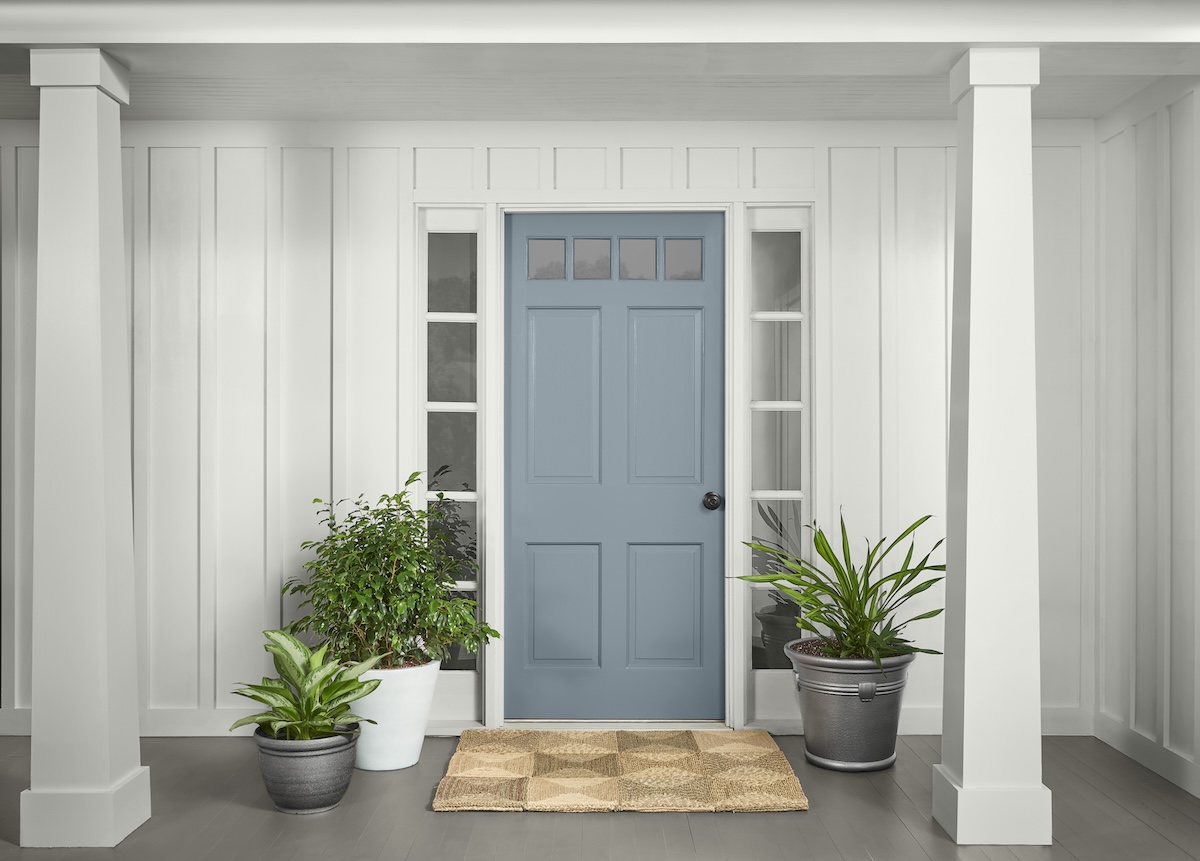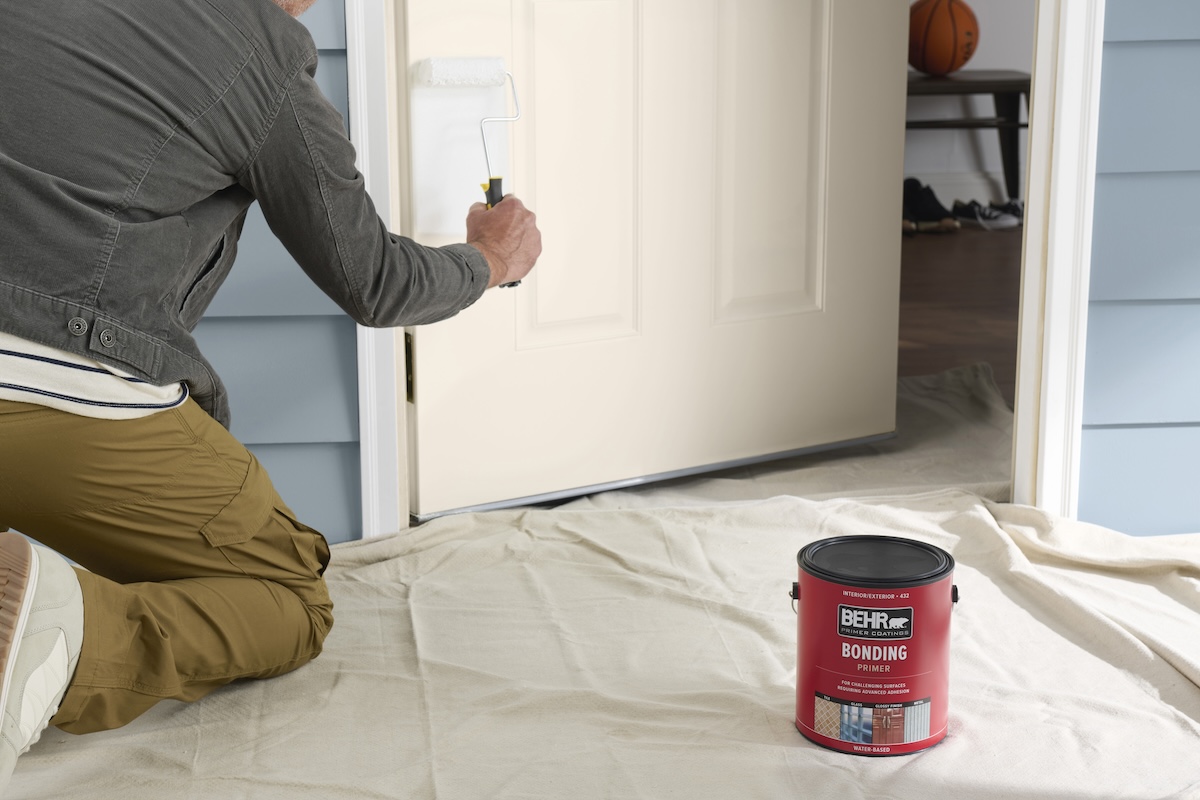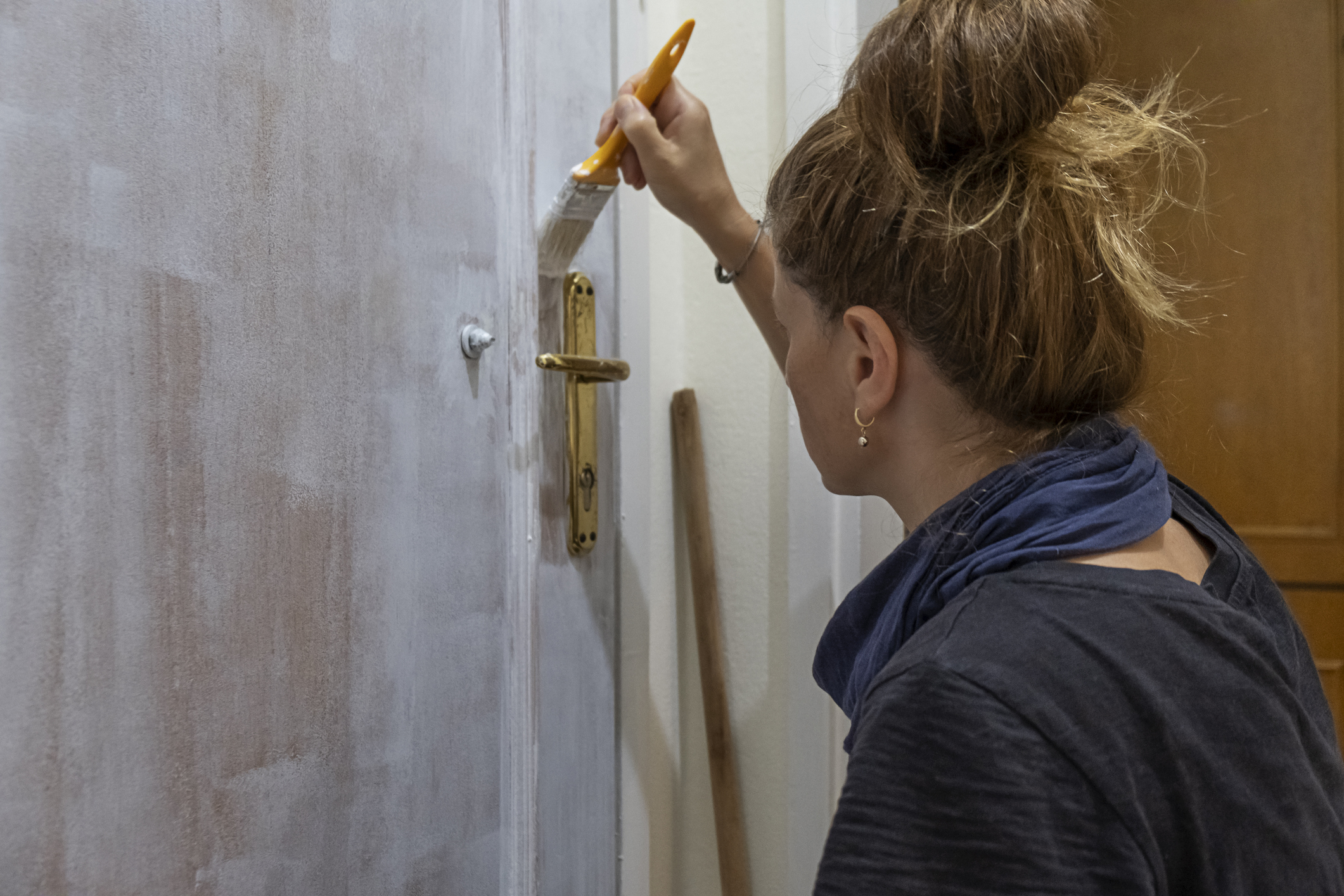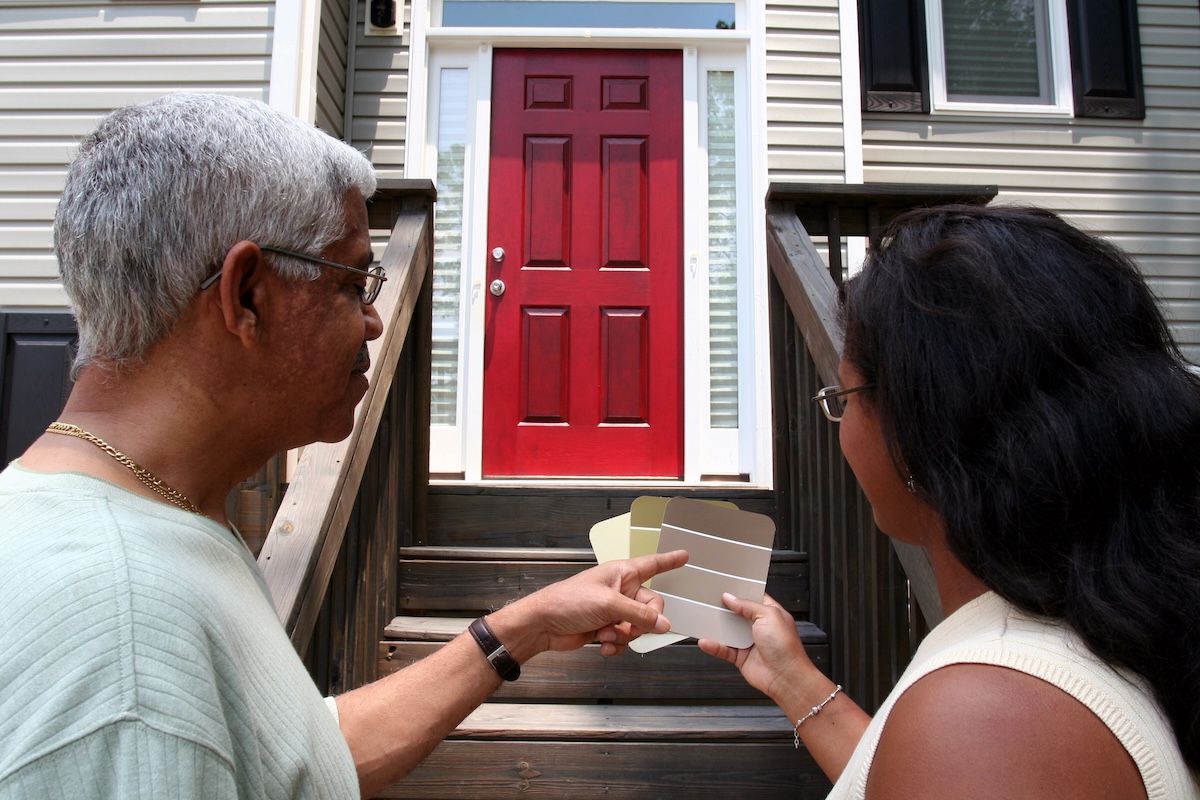

We may earn revenue from the products available on this page and participate in affiliate programs. Learn More ›
Your front door is one of the hardest-working parts of your house. Not only does it have to withstand whatever weather Mother Nature throws at it, but it also has to deal with being opened and closed, slammed shut, and nudged open with elbows and feet when we’re carrying way too many bags of groceries. Sometimes a little paint touch-up is all that’s needed to keep the front door looking its best.
However, touch-ups only go so far. Setting aside time to refresh the door with a new coat of paint can do wonders for your home’s curb appeal, and a fresh coat can help protect the door and keep it in service much longer, too.
“Painting your entry door is one of the simplest ways to boost your home’s curb appeal. But not all doors, or paints, are the same,” says Michael Iler, product manager at Dutch Boy Paints. “To get a long-lasting result, it’s important to prep properly and choose the right primer and paint for your door’s material.”
Read on to learn how to pick the best paint for front doors and discover some color selection and application tips to ensure professional-quality results.
How to Pick the Right Paint for Your Front Door

While the color of the paint is a personal choice, the best type of paint for front doors is based on the door’s material.
Wood doors
Choosing an exterior paint for wood doors may seem simple, but there’s more to it. For example, it’s essential to know that some wood species tend to bleed more than others. “Bleeding” occurs when the wood releases tannins, leading to staining or color deterioration.
Paint for wood that bleeds
For cedar, cypress, or other woods that bleed, choose an oil-based exterior paint like Rust-Oleum Protective Enamel. Oil-based paint is less susceptible to unattractive tannin bleed-through. Tannins can seep into water-based paint, leaving yellowish-brown splotches in the final result.
“A multi-surface primer, such as Behr Multi-Surface Stain-Blocking Primer & Sealer, effectively handles tannin bleed and works well on both natural and composite wood surfaces,” says Ed Edrosa, senior product manager at Behr.
Primer recommendation: Behr Multi-Surface Stain-Blocking Primer & Sealer
Paint recommendation: Rust-Oleum Protective Enamel
Paint for wood that doesn’t bleed
For a door made of pine, white fir, or any other wood species that doesn’t bleed, choose a stain-blocking primer and a water-based exterior paint. Water-based paint emits fewer fumes, dries faster, and results in less color fading.
Primer recommendation: Behr Multi-Surface Stain-Blocking Primer & Sealer
Paint recommendation: Behr Premium Plus Ultra Exterior Paint and Primer
Metal doors

The best paint for metal front doors, such as steel storm doors, is usually an oil-based paint that can stave off rust formation.
“For metal doors, you want to make sure that there is no rust before applying any latex primer or paint. For any areas showing rust, it should be cleaned and primed using a primer designed to control rust—for example, All Surface Enamel Oil Primer,” says Dennis Fiorilli, senior director of product information and excellence at Sherwin-Williams.
“Then use Platinum Plus Cabinet, Door & Trim paint for a durable, smooth finish that holds up to weather and resists fading,” adds Iler of Dutch Boy.
Primer recommendation: Sherwin-Williams All Surface Enamel Oil Primer
Paint recommendation: Dutch Boy Paints Platinum Plus Cabinet, Door & Trim
Fiberglass doors
Even though they are usually made to look like wood, fiberglass doors, unlike actual wood doors, tend to be slick. After a coat of primer, a water-based paint can be applied to the slick surface of fiberglass more easily than thicker, stickier oil-based paints. Fiberglass also benefits from a primer designed for challenging surfaces.
“A bonding primer like Behr Bonding Primer is best suited for smooth, nonporous surfaces to promote proper adhesion,” says Edrosa.
Primer recommendation: Behr Bonding Primer
Paint recommendation: Sherwin-Williams Latitude Exterior
Tips for Painting a Front Door

Even after you have picked the best paint for exterior doors, there’s still plenty to know before you get started. Consider this professional guidance when tackling your front door paint project for great-looking, long-lasting results.
Select the right paint applicators.
A cheap paint brush or roller may be easy on the wallet, but it won’t deliver the same results as a quality applicator. Also, if a door has raised panels or glass, you will need a few different applicators for the one entry door.
“A brush should be used in areas a roller cannot reach—such as recessed areas, panels, and framing around windows—and a mini roller is going to help provide a smooth, uniform finish on the larger flat surfaces of the door,” says Chris Gurreri, product manager at Purdy. “We recommend using applicators that leave a smooth finish, like the Purdy Nylox Brush and Purdy WhiteDove Mini Roller, regardless of the surface.”
Paint brush recommendation: Purdy Nylox Glide Brush
Roller recommendation: Purdy White Dove Mini Roller
Choose the right paint finish.
While you can choose any exterior paint finish for your entry door, most pros use a semi-gloss or satin finish because those finishes are more durable and easier to clean than flat. A gloss finish is even easier to clean, but it can exaggerate any imperfections in the door’s surface. The higher the level of gloss, the less likely it is that the paint will fade, too.
Time it right.
Spring and fall are ideal seasons for outdoor paint jobs. Opt for dry, sunny, calm conditions with temperatures between 40 and 90 degrees Fahrenheit for oil-based paint and 50 to 85 degrees Fahrenheit for latex paint. Start early in the day so the door will be dry enough by evening to reattach hardware without marring the paint finish.
Remove the door.
This is a surefire way to protect your door casing and entryway from paint drips and blobs. Remove the door and place it on two sawhorses in a convenient area without trees overhead, such as the driveway or a section of the yard.
Prep for paint.
Sand off any chipped paint (or the entire door surface, if need be). Wash off dust and dirt with a sponge and mild detergent, then let the door dry fully. Remove all hardware.
Apply primer.
If the entry door has never been painted, it’s essential to prime first. Even if it has been painted, we still recommend priming first in order to achieve a pro-level finish without having to apply more than two coats. “Don’t skip the primer, especially if switching to a bold new color,” says Iler.
Apply paint in sections.
Paint details like trim and edges first, then apply paint to the panels. Roll out the larger flat surfaces last and, for wood doors, in the direction of the grain.
Let it set.
Allow the door to dry fully before reattaching locks and knobs. Trying to attach hardware before the paint is dry could damage the finish.
Tips for Choosing Front Door Color

While black and dark gray doors rate high when it comes to resale value, there’s no reason you can’t choose your favorite color for your door. As you’re browsing through paint chips, weigh these considerations as you choose a front door color.
- Get samples. Paint chip cards can tell you only so much. The lighting and color of fixed features near the door will change how a color appears. So, invest in a few sample cans of paint in different hues, brush some swatches on the door in several locations (or use painter’s tape to attach swatches to the door), and see how the colors look at different times of day.
- Choose a complementary color. Pick a front door paint color that complements the color of your home’s siding, trim, and shutters. A blue front door, for example, would pair well with white trim and brown siding.
- Keep it simple. If you want the front door paint project to go quickly, choose a new color similar to or slightly darker than the current color. To apply a lighter color over a darker one, you may need to give the door two full coats of primer and allow time for the second coat to dry and set before painting two coats of the chosen color.
Perk up the inside. The interior and exterior surfaces of your front door needn’t be the same color. If you pick a low-key color to face the outside world, but your home decor and personality in general are more cheerful, apply a fun, vibrant hue to the inside surface.
FAQs
Even the best front door paint can fade a little over time, but some are less likely to noticeably fade. “Use paint with built-in UV protection,” says Iler. “Choose lighter colors; they hold up better under sun exposure.”
Before you start to paint your entry door, always make sure the surface is dry. “For mold and mildew resistance, using high-quality exterior paints can help protect surfaces, but proper preparation and maintenance are just as important. Controlling moisture exposure and sealing gaps are crucial for enhancing durability, maintaining surface appearance, and reducing the risk of mold and mildew growth,” says Edrosa.
A quart of paint is usually enough to apply two coats to a primed standard entry door. Keep in mind that you can always order paint online for delivery.
